


xxxxxThe American short-
EDGAR ALLAN POE 1809 -
Acknowledgements
Poe: pen and ink drawing by Irish illustrator Harry Furniss (1854-
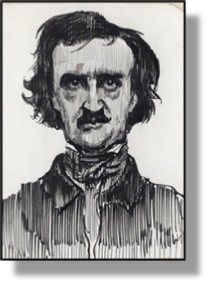 xxxxxThe American short-
xxxxxThe American short-
xxxxxPoe was born in Boston, Massachusetts. His parents, both touring actors, died before he was three years old, and he was brought up by John Allan, a successful merchant in Richmond, Virginia, who was probably his godfather. Under his guidance he attended a private school in England for five years, and entered the University of Virginia in 1826. Here, however, he ran up gambling debts and began drinking heavily. His foster father refused to support him, and he was obliged to leave after a year and join the army. By this time, however, he was showing talent as a poet, and in 1830 he found a ready means of escaping from the army by deliberately disobeying orders! In 1831 his third book, Poems, a 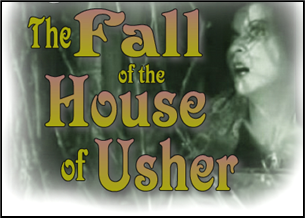 work largely influenced by the English romantics, was well received but, in order to make a living he wrote a series of amusing stories for the Philadelphia Saturday Courier. Then in 1835, having moved to Richmond, Virginia, he became editor of the Southern Literary Messenger. This provided an outlet for his fiction -
work largely influenced by the English romantics, was well received but, in order to make a living he wrote a series of amusing stories for the Philadelphia Saturday Courier. Then in 1835, having moved to Richmond, Virginia, he became editor of the Southern Literary Messenger. This provided an outlet for his fiction -
xxxxxOver the next ten years or so he struggled to make a name for himself, first in Philadelphia, and then in New York. But whilst he met with limited success as a literary journalist, it was during this period that he wrote the short stories of mystery, horror and violence which brought him recognition and ensured his place in world literature. His famous work The Fall of the House of Usher, published in 1839, was full of gloom and foreboding, and he followed this with his Tales of the Grotesque and Arabesque, his gruesome A Descent into a Maelstrom, and his The Murders in the Rue Morgue, a 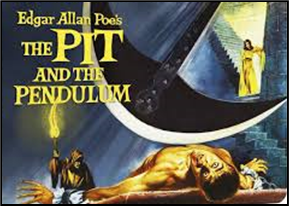 macabre tale which introduced the able sleuth Inspector Dupin, the forerunner of a long line of fictional detectives who solved crimes by mere deduction. There followed a series of gothic romances, full of fantasy, mystery and suspense. These included The Masque of the Red Death, The Pit and the Pendulum (a particularly gruesome tale), The Gold Bug, The Tell-
macabre tale which introduced the able sleuth Inspector Dupin, the forerunner of a long line of fictional detectives who solved crimes by mere deduction. There followed a series of gothic romances, full of fantasy, mystery and suspense. These included The Masque of the Red Death, The Pit and the Pendulum (a particularly gruesome tale), The Gold Bug, The Tell-
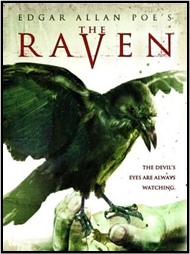 xxxxxPoe’s fascination with the mysterious and supernatural has tended to overshadow his ability as a poet. His works, such as Ulalume, The Sleeper and The Bells, have a lyrical beauty all of their own, and the sad, haunting theme which makes up The Raven, produced in 1845, is one of the gems of American literature. And moving, too, is his Annabel Lee, a lamentation commemorating the death of his wife in 1847.
xxxxxPoe’s fascination with the mysterious and supernatural has tended to overshadow his ability as a poet. His works, such as Ulalume, The Sleeper and The Bells, have a lyrical beauty all of their own, and the sad, haunting theme which makes up The Raven, produced in 1845, is one of the gems of American literature. And moving, too, is his Annabel Lee, a lamentation commemorating the death of his wife in 1847.
xxxxxAs befits Poe, a certain amount of mystery surrounds his death in 1849, aged 40. Following a lecture tour in Richmond, he was found lying unconscious on a street in Baltimore, and his subsequent death was attributed to a “congestion of the brain”. Drugs and alcohol might well have contributed to his death, though according to his family he had abstained from both for some time.
xxxxxPoe was a strange mixture of a man. His tales of horror and fantasy were no doubt the product of troubled dreams and a weird, fertile imagination, but in his literary criticism he was capable of a logical approach and a well-
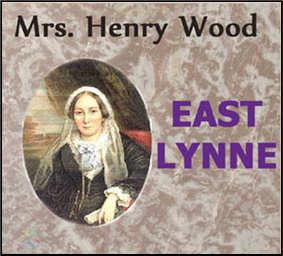
xxxxxAn English pioneer of crime fiction at this time was the novelist Mrs Henry Wood, born Ellen Price (1814-
xxxxxA good storyteller, Mrs Wood wrote close on 40 novels, the majority following melodramatic themes, and many centred around crime and its dire consequences. Most successful among these potboilers was Mrs Halliburton's Troubles and The Channings, both published in 1862. In 1867 she became proprietor of the Argosy magazine, and it was in this journal that she produced a series of short stories under the title The Johnny Ludlow Papers.
Including:
Mrs Henry Wood,
Charles Baudelaire
and Gustave Flaubert

xxxxxAs noted above, the French poet Charles Baudelaire (1821-
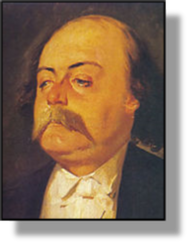 xxxxxAnd another Frenchman whose first major work was considered indecent was Gustave Flaubert (1821-
xxxxxAnd another Frenchman whose first major work was considered indecent was Gustave Flaubert (1821-
xxxxxFlaubert was born in Rouen, Normandy, the son of a surgeon. After studying law in Paris for two years, he turned to writing as a career. He made a two-
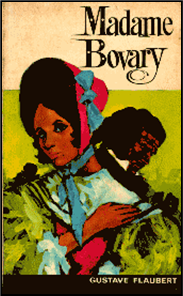 xxxxxAs a writer Flaubert constantly revised and polished his work to ensure that his style was pure and precise, and by shrewd observation and a remarkable eye for detail he produced realistic social settings for all his novels, combined with a penetrating study of character. His masterpiece Madame Bovary, written over five years, tells the fate of Emma, the wife of a country doctor who, seeking romantic love, embarks on a series of disastrous love affairs, and is eventually driven to take her own life. By it, Flaubert aimed to show the boring, drab nature of bourgeois life at this time, riddled, as he saw it, by illusions of grandeur. The novel that followed, Salammbo, an
xxxxxAs a writer Flaubert constantly revised and polished his work to ensure that his style was pure and precise, and by shrewd observation and a remarkable eye for detail he produced realistic social settings for all his novels, combined with a penetrating study of character. His masterpiece Madame Bovary, written over five years, tells the fate of Emma, the wife of a country doctor who, seeking romantic love, embarks on a series of disastrous love affairs, and is eventually driven to take her own life. By it, Flaubert aimed to show the boring, drab nature of bourgeois life at this time, riddled, as he saw it, by illusions of grandeur. The novel that followed, Salammbo, an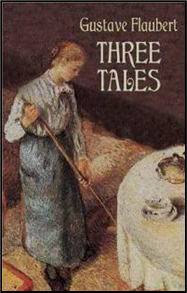 exotic tale set in ancient Carthage, was the most romantic of his works and gained him recognition at court and a place among the literary élite in Paris.
exotic tale set in ancient Carthage, was the most romantic of his works and gained him recognition at court and a place among the literary élite in Paris.
xxxxxBut his next publications, A Sentimental Education, produced just before the outbreak of the Franco-
xxxxxFlaubert was a close friend of the novelist George Sand and, from 1867, gave encouragement and guidance to the short-
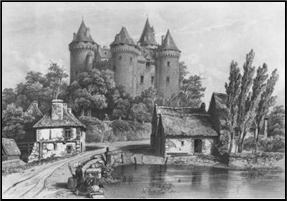
xxxxxIncidentally, some of Flaubert’s best writing was published after his death, contained in a journal entitled Par les champs and par les grèves (Over fields and shores). This gave a superb account of a walking tour he made with a friend along the Loire and the coast of Brittany in 1847, during which they visited a medieval castle amid the woodland at Combourg (illustrated), the family home of the French writer and diplomat Chateaubriand.
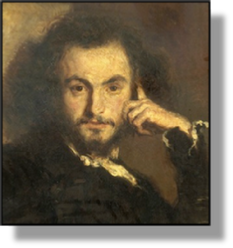 xxxxxAs noted above, the French poet Charles Baudelaire (1821-
xxxxxAs noted above, the French poet Charles Baudelaire (1821-
xxxxxBaudelaire’s major work, and perhaps the only one by which he is remembered today, was his Flowers of Evil, his first book of verse, published in 1857. Having inherited a large fortune as a young man, Baudelaire settled in Paris in the early 1840s, and for some years was able to live the life of a “dandy”. It was when this money started to run out that he began composing his poems, assisted it would seem by an addiction to opium and hashish and the “artificial paradises” these drugs produced. He became recognised as a poet of exceptional talent and originality after the publication of The Flowers of Evil, but alongside his technical skills went a love of eroticism and a morbid fascination for all that was seen as evil, depraved and ugly in the world. In particular, he regarded life in Paris as a wretched, lonely existence, without hope or purpose.
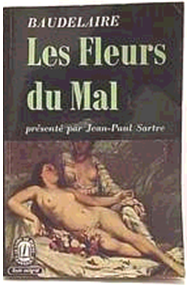 xxxxxNot surprisingly his volume of poems landed him in court, where he was found guilty of offending public morals. He was fined, and six of his poems were banned from further publication. He had no defence against the charge but, subject matter apart, his verse demonstrated a mystical, subtle power of language which was to have a significant influence on the shape and development of modern poetry. From out of a sordid study of ugliness he produced verse of classical beauty, achieved in large measure by his gift for musical language and what he termed his “correspondances”, associations of ideas which stressed the role of imagery as a poetic technique. This paved the way for symbolism, a movement which was to gather strength later in the century.
xxxxxNot surprisingly his volume of poems landed him in court, where he was found guilty of offending public morals. He was fined, and six of his poems were banned from further publication. He had no defence against the charge but, subject matter apart, his verse demonstrated a mystical, subtle power of language which was to have a significant influence on the shape and development of modern poetry. From out of a sordid study of ugliness he produced verse of classical beauty, achieved in large measure by his gift for musical language and what he termed his “correspondances”, associations of ideas which stressed the role of imagery as a poetic technique. This paved the way for symbolism, a movement which was to gather strength later in the century.
xxxxxThe last years of Baudelaire’s life were full of despair. He was declared bankrupt in 1862 and this added to his sense of failure. In 1864 he went to live in Belgium, but his sudden deterioration in health forced him to return to Paris in less than two years. He was admitted to a clinic and died the following year from brain damage.
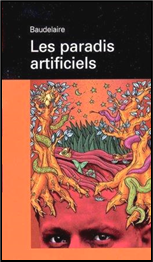
xxxxxHe wrote a number of works in addition to The Flowers of Evil. He produced his autobiographical novel La Fanfarlo in 1847, and published appraisals of the novelists Honoré de Balzac and Gustave Flaubert around that time. His Les paradis artificiels of 1860 deals with his addiction to drugs and was very much on the lines of De Quincey’s Confessions of an English Opium Eater. His collection of fifty prose poems, often known as Spleen de Paris, and My Heart Laid Bare, were published after his death.
xxxxxIncidentally, in the mid 1840s, before he embarked on his poetic career, he produced Les salons, two pamphlets on art criticism in which his comments on various contemporary artists -
xxxxx…… In the revolution of 1848 Baudelaire took part in the street fighting, and also helped to produce Le Salut Public, a magazine supporting the rebellion. The cover for this production was illustrated by a parody of Delacroix’s famous Liberty Leading the People, the work of his friend, the French realist artist Gustave Courbet.
Va-
xxxxxAnother French writer whose first major work was considered indecent was Gustave Flaubert (1821-


